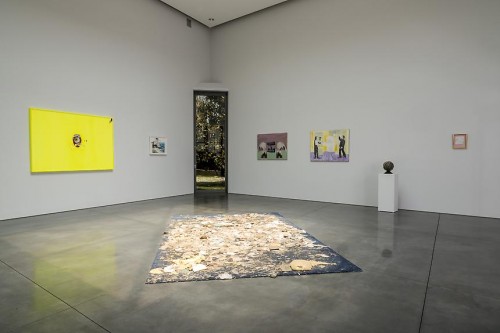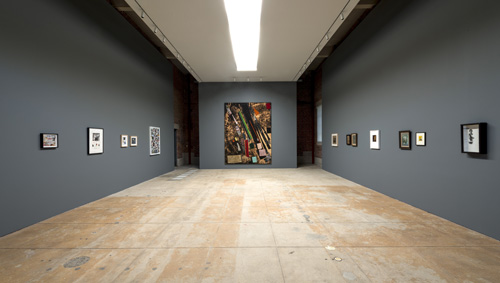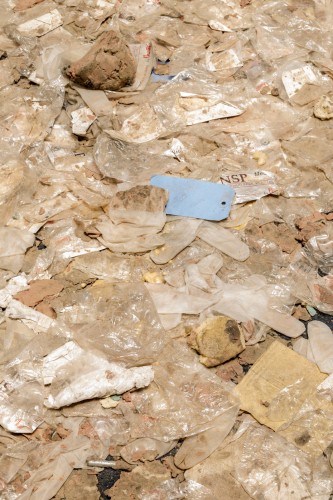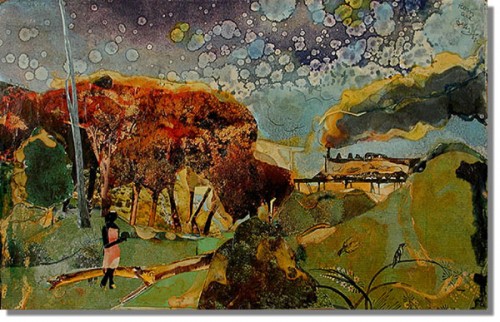
Mash Up: Collage from 1930 to the present, installation view East Gallery L & M Arts. Courtesy L & M Arts. Photo by Joshua White/ JW Pictures.
While music mashups aim to synthesize multiple songs into a whole greater than the sum of its parts, they often linger in the realm of clunkiness, without improving on the original songs. Occasionally, however, mashups achieve a new totality and reveal something new about a familiar tune.
When you put works by John Baldessari, Barbara Kruger, Joseph Cornell, Mark Bradford, and a host of other contemporary powerhouses into a single space, the results can vary. But the star-studded lineup of L&M Arts’ summer exhibition, Mash Up: Collage from 1930 to the present explores the lineage of collage without forcing connections through overdetermined themes, and allows the plurality of contemporary art and the medium of collage to celebrate the heterogeneity of our world.

L&M Arts West Gallery installation view. Courtesy L&M Arts. Photo by Joshua White/ JW Pictures.
Sterling Ruby’s mammoth quilted panel anchors the West Gallery wall, dynamically patching ethnic south American woven cloths with retro denim, washcloths, and blankets in an abstract expressionistic explosion of texture and garish color. While Ruby’s powerhouse piece serves to electrify the packed gallery, the surrounding more subdued works vibrate with subtle nuance. The adjacent wall features three exquisite works by Joseph Cornell, whose signature borderline-kitsch heart stickers, cherub images, and coins transcend contemporary ironic readings.

Aaron Curry. "Bag of Sags," 2012. Collage and gouache on board. Courtesy L&M Arts. Photo by Joshua White/ JW Pictures.
Meanwhile, the somber currents of the West Gallery find a counterbalance with the sunlit-soaked, maximalist psychedelic motifs found throughout the East Gallery. Just as the relatively young Ruby dominates the entrance-facing rear wall of the West Gallery, his contemporary Aaron Curry anchors the rear wall of the East Gallery with the day-glo colors of his cartoonish pieces, Dopesmoker and Bag of Sags.

Paul McCarthy. "Carpet (D)," 2009-2011. Clay, plastic, and gloves on carpet. Courtesy L & M Arts. Photo by Joshua White/ JW Pictures.
Across the large expanse of the floor lies Paul McCarthy’s Carpet (D)—one of the show’s few forays into the third dimension. Comprised simply of a generic carpet encrusted with disposable gloves, hardened spray foam, and general art studio detritus, Center transcends straightforward abjection. Rather than simply repositioning vestigial studio junk in the context of a clean gallery space, Center immerses and transports the viewer to a separate reality of the artist’s studio.
Marnie Weber, one of the few female artists represented in Mash Up, also aims to create a separate reality for her viewers. Howling for the Return (Brompton Cemetery, London, England) is populated by her recurring bemasked Victorian-clad female figures perched on headstones and surrounded by wolves. Offsetting the conceptual and stylistically crude threads running throughout the show, Romare Bearden’s Heavy Freight: Mecklenburg Evening stands out, with a delicate, painterly figure in a vast landscape.

Romare Bearden. "Heavy Freight/ Mecklenburg Evening," 1982. Estate of Romare Bearden. Courtesy L&M Arts. Photo by Joshua White/ JW Pictures.
As Catherine Wagley discussed in this month’s earlier Looking at Los Angeles post, summertime tends to be dominated by endless group exhibitions whose curators often force connections between works through an overdetermined idea or curatorial thesis, or else leave the viewer adrift in a sea of contemporary plurality. Mash Up succeeds in exploring the spiraling heterogeneity of the past 90 years of artmaking without losing track of ongoing themes.



